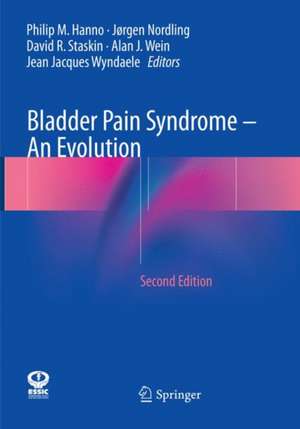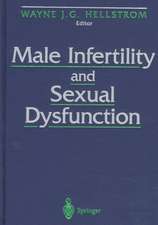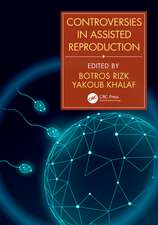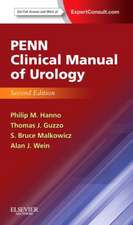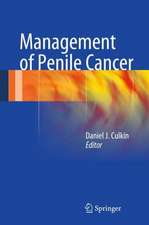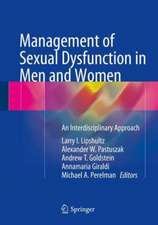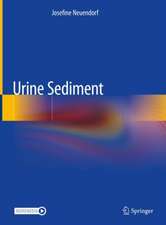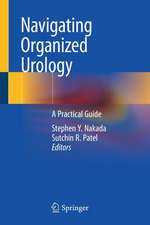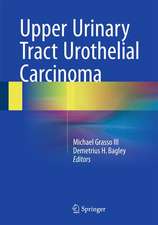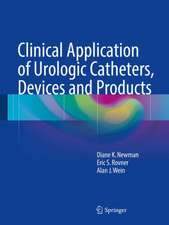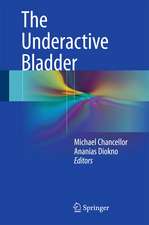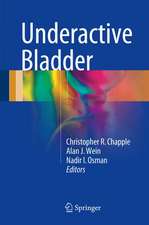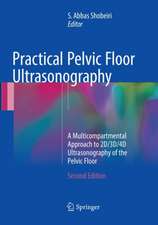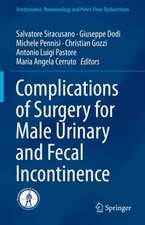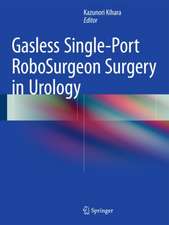Bladder Pain Syndrome – An Evolution
Editat de Philip M. Hanno, Jørgen Nordling, David R. Staskin, Alan J. Wein, Jean Jacques Wyndaeleen Limba Engleză Paperback – 24 aug 2018
The book aims to give healthcare providers up to date guidelines and management suggestions within a quick-reference text.
This book is relevant to clinicians who focus on bladder pain syndrome, as well as the gynaecologists, general urologists, and primary care providers who see these patients as a part of their practice.
| Toate formatele și edițiile | Preț | Express |
|---|---|---|
| Paperback (1) | 893.67 lei 38-44 zile | |
| Springer International Publishing – 24 aug 2018 | 893.67 lei 38-44 zile | |
| Hardback (1) | 917.52 lei 38-44 zile | |
| Springer International Publishing – 16 noi 2017 | 917.52 lei 38-44 zile |
Preț: 893.67 lei
Preț vechi: 940.70 lei
-5% Nou
Puncte Express: 1341
Preț estimativ în valută:
170.100€ • 179.02$ • 141.49£
170.100€ • 179.02$ • 141.49£
Carte tipărită la comandă
Livrare economică 01-07 aprilie
Preluare comenzi: 021 569.72.76
Specificații
ISBN-13: 9783319870823
ISBN-10: 3319870823
Pagini: 175
Ilustrații: VII, 175 p. 177 illus., 108 illus. in color.
Dimensiuni: 178 x 254 x 14 mm
Greutate: 0.4 kg
Ediția:Softcover reprint of the original 2nd ed. 2018
Editura: Springer International Publishing
Colecția Springer
Locul publicării:Cham, Switzerland
ISBN-10: 3319870823
Pagini: 175
Ilustrații: VII, 175 p. 177 illus., 108 illus. in color.
Dimensiuni: 178 x 254 x 14 mm
Greutate: 0.4 kg
Ediția:Softcover reprint of the original 2nd ed. 2018
Editura: Springer International Publishing
Colecția Springer
Locul publicării:Cham, Switzerland
Cuprins
Section 1 Introduction.- 1 Interstitial Cystitis: An Introduction to the Problem.- 2 Historical Perspectives.- Section 2 Epidemiology and Etiology.- 3 Epidemiology of Interstitial Cystitis: 1.- 4 Epidemiology of Interstitial Cystitis: 2.- 5 Interstitial Cystitis: Animal Models.- 6 Etiology: Etiologic and Pathogenic Theories in Interstitial Cystitis.- Editorial Comment Etiologic Theories: Deficiency of the Bladder Lining.- Section 3 Diagnosis.- 7 Light Microscopic Findings in Bladders of Patients with Interstitial Cystitis.- 8 Pathology of Interstitial Cystitis.- 9 Mast Cells and Interstitial Cystitis.- 10 Diagnosis of Interstitial Cystitis: A Clinical, Endoscope and Pathologic Approach.- 11 Neurourologic Evaluation in Interstitial Cystitis.- 12 Hydrodistention and Intraoperative Urodynamics.- Editorial Comment The Clinical Evaluation of Patients with Painful Bladder Disease.- Interstitial Cystitis.- Section 4 Management.- 13 Pharmacotherapeutic Goals in Interstitial Cystitis.- 14 Intravesical Therapy of Interstitial Cystitis.- 15 Subcutaneous Heparin in the Treatment of Interstitial Cystitis.- 16 Urine Eosinophil Cationic Protein in Painful Bladder Disease.- 17 Use of Pentosanpolysulfate in the Management of Interstitial Cystitis.- 18 Use of Transcutaneous Electrical Nerve Stimulation in the Management of Chronic Interstitial Cystitis.- 19 Reappraisal of Transurethral Resection in Classic Interstitial Cystitis.- 20 Treatment of Interstitial Cystitis with the Neodymium:YAG Laser.- 21 Partial Bladder Denervation in the Treatment of Interstitial Cystitis in Women.- 22 Surgical Therapy of Interstitial Cystitis.- Editorial Comment Substitution Cystoplasty in the Management of Interstitial Cystitis.- Addendum. Summary of the 1989 AUA Podium Section on Genitourinary Infection: Interstitial Cystitis.
Notă biografică
Philip M. Hanno, MD, MPH, has a long-standing interest in bladder pain syndrome and female urology, and is Co-Chair of the Medical Advisory Board of the Interstitial Cystitis Association. He is chair of the American Urological Association Guideline Committee on Interstitial Cystitis. He has been Chief of the Division of Urology of the Philadelphia Veterans Administration Medical Center and Professor and Chair of the Department of Urology at Temple University School of Medicine. He was a Medical Officer in the Division of Reproductive and Urologic Drugs in the Food and Drug Administration. He is currently an Emeritus Professor of Urology at the University of Pennsylvania and is Clinical Professor of Urology at Stanford University School of Medicine.
Alan J. Wein, MD, PhD(hon.), FACS Alan J. Wein, MD, PhD(hon.), FACS is the Founders Professor of the Division of Urology at the University of Pennsylvania School of Medicine, Director of theResidency Program in Urology at the University of Pennsylvania. He is a graduate of Princeton University and received his MD from the University of Pennsylvania School of Medicine. He completed training in Surgery and Urology at the University of Pennsylvania including a fellowship at the Harrison Department of Surgical Research. He has been certified and recertified (voluntary) by the American Board of Urology. He was awarded an honorary Ph.D. from the University of Patras, Greece in September 2005. He was made an honorary professor of the Federal State Institute of Urology of Russia in 2010.
Alan J. Wein, MD, PhD(hon.), FACS Alan J. Wein, MD, PhD(hon.), FACS is the Founders Professor of the Division of Urology at the University of Pennsylvania School of Medicine, Director of theResidency Program in Urology at the University of Pennsylvania. He is a graduate of Princeton University and received his MD from the University of Pennsylvania School of Medicine. He completed training in Surgery and Urology at the University of Pennsylvania including a fellowship at the Harrison Department of Surgical Research. He has been certified and recertified (voluntary) by the American Board of Urology. He was awarded an honorary Ph.D. from the University of Patras, Greece in September 2005. He was made an honorary professor of the Federal State Institute of Urology of Russia in 2010.
David R. Staskin, M.D. Dr. Staskin is an associate professor of urology at Tufts University. He held similar positions at New York Presbyterian Hospital-Cornell and Beth Israel Deaconess Medical Center-Harvard. Dr. Staskin has an international reputation in lower urinary tract pharmacology and devices. He has specific expertise in pharmaceuticals used to treat overactive bladder and stress incontinence. He was member of HHS-AHCPR and a Section Chairperson of ICI-WHO. He has held advisory positions with numerous pharmaceutical and medical device companies.
Textul de pe ultima copertă
This updated volume provides reflections on the original edition, as well as information on the developments that have occurred within bladder pain syndrome since the publication of the first edition. The epidemiology, etiology, diagnosis, and management of bladder pain syndrome are all covered.
The book aims to give healthcare providers up to date guidelines and management suggestions within a quick-reference text.
This book is relevant to clinicians who focus on bladder pain syndrome, as well as the gynaecologists, general urologists, and primary care providers who see these patients as a part of their practice.
The book aims to give healthcare providers up to date guidelines and management suggestions within a quick-reference text.
This book is relevant to clinicians who focus on bladder pain syndrome, as well as the gynaecologists, general urologists, and primary care providers who see these patients as a part of their practice.
Caracteristici
Current guidelines compiled from the United States, Europe and Asia will be provided, which discuss disease management to give the reader a quick reference guide Contains chapters from members of the International Association for the Study of Bladder Pain Syndrome Written from a global perspective Includes supplementary material: sn.pub/extras
